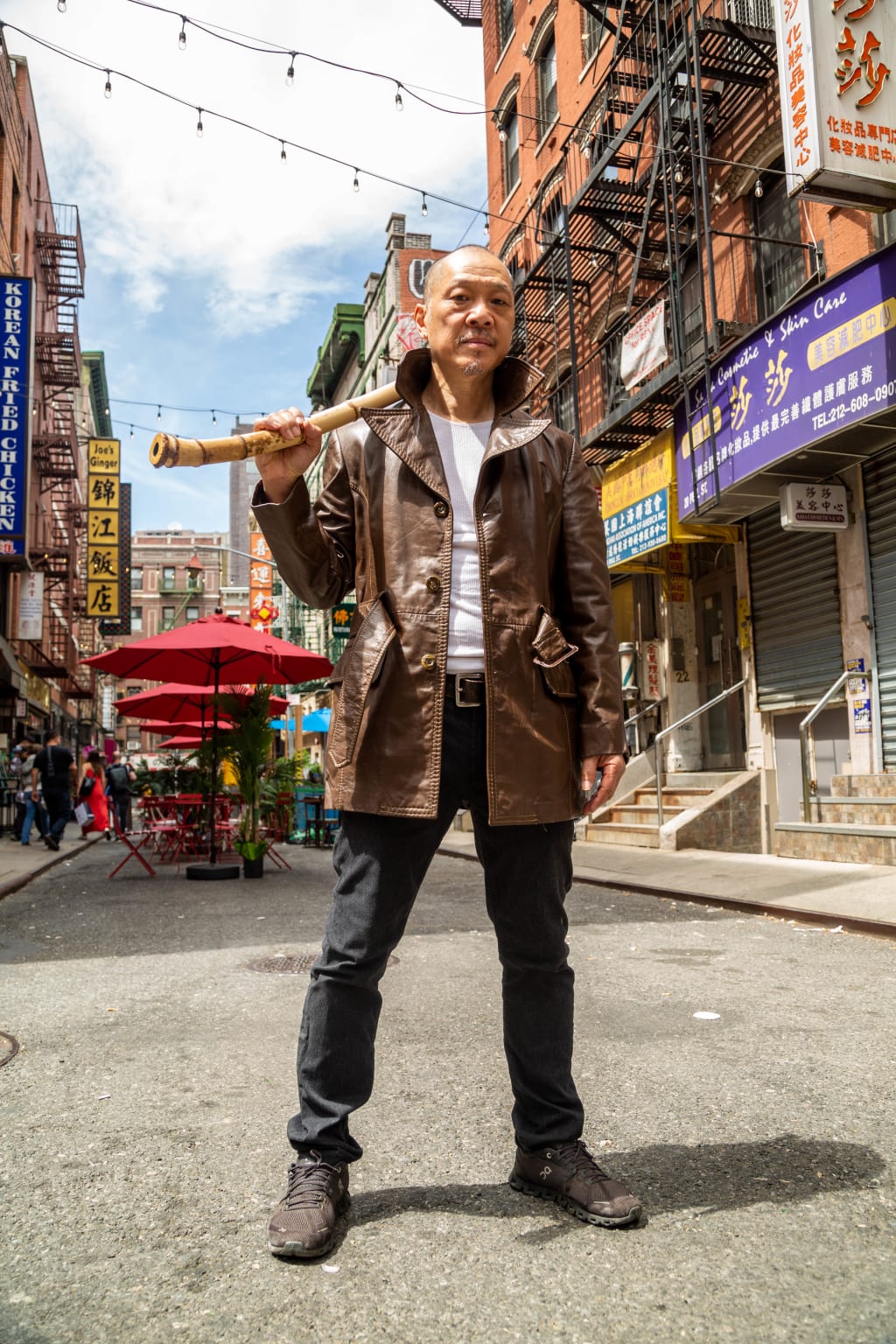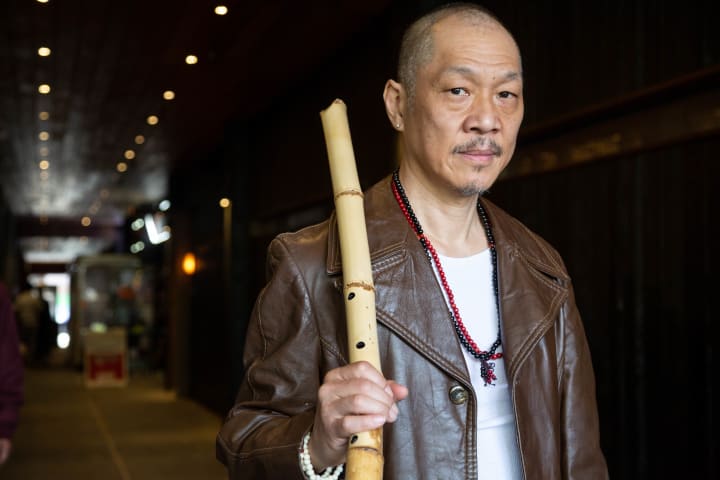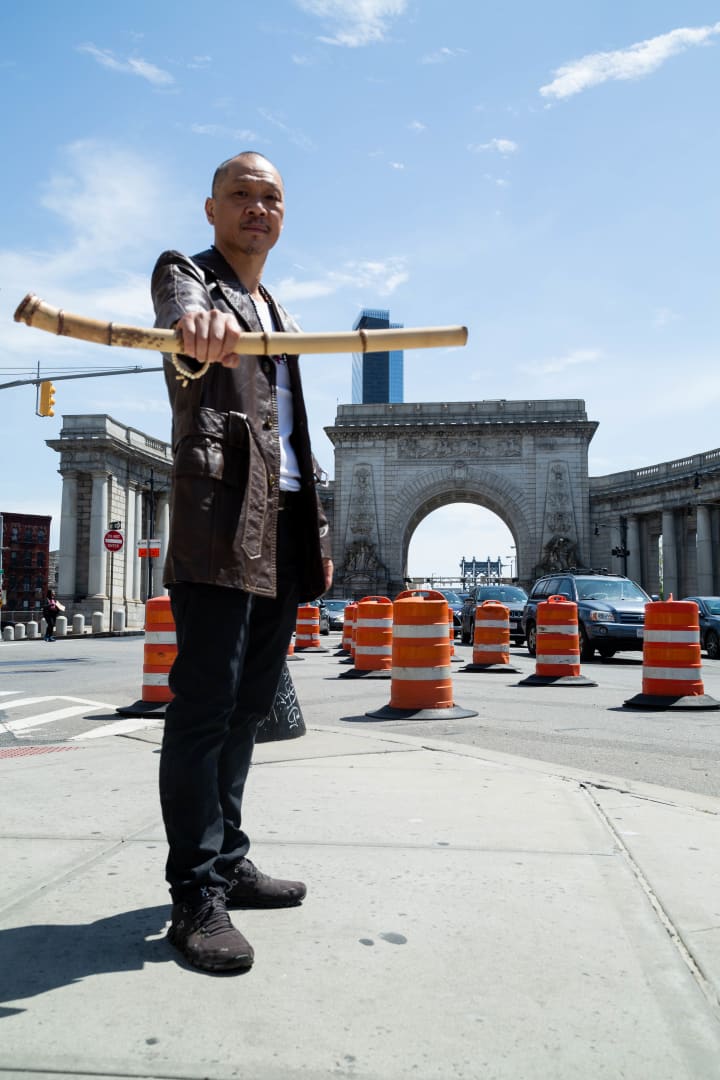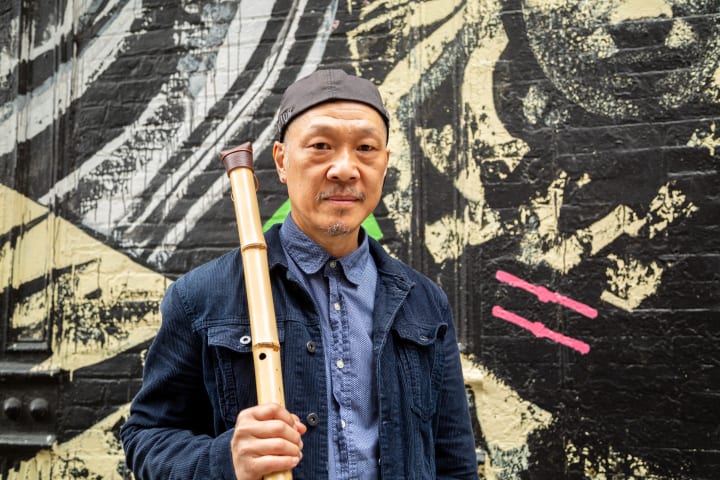
This is an interview I had and photoshoot put together with Perry Yung for Azzara Magazine; unfortunately this was the last article to be placed into the magazine but never got it’s spotlight when the owner passed in November 2021. I apologize for those waiting for the publication but I wanted to put up their interview and photos.
Cadma: Hey Perry Yung! We picked you up after wrapping on another set. Tell us more about this PSA?
Yung: The idea sprang from Teresa Ting’s work in starting Mainstreet Patrol, a grass roots community group, to provide chaperones for the elderly in Flushings, Queens to keep our elders safe against racist attacks. The song was written by singer/lawyer Calista Wu and directed by Ron Yuan, the actor director known for his role in Marco Polo and director of the 47 Ronin film sequel.
Cadma: Will you be doing more projects like this, that will be coming out soon?
Yung: I’ve been participating in rallies, marches and a lot of zoom/online panel discussions about anti-Asian violence and the need for solidarity. Especially during the month of May, as it’s Asian Pacific American Heritage Month. I’ll be the keynote speaker for the National Day of Solidarity in Washington DC; which will take place on the National Mall. It's such an honor to be making a speech about unity on the spot where Martin Luther King made his famous “I Have a Dream” speech.
Cadma: You play the role of Father Jun in the hit HBO show “Warriors”, tell us about “Warrior” & what Father Jun represents in the show?
Yung: On a topical level, Father Jun is the head of the most dangerous and powerful Tong in 1870’s San Francisco Chinatown. He is the Chinese threat to White society. However, the subtext for the character is one of activism and resistance. My interpretation of Father Jun is based on Malcom X. White society sees him as the enemy but he’s just trying to protect his people from violence of the “Ducks” (a slang for White people used in Warrior.) Father Jun’s backstory is that he was a soldier who fought the Opium War just thirty years earlier; this tells me he’s a revolutionary who has been fighting White supremacy for a large part of his life. Like Malcom, he loves his people and puts his own life on the line for them.

Cadma: There is a drastic difference in Father Jun’s relationship with his community versus with his son, what is the lesson for the community that he seems to want to teach versus a lesson he is consistently trying to teach his son?
Yung: In the 1870s, and even in today’s Chinese America, the Chinese were heavily influenced by Confuscianist thought; where there is a hierarchy in society and everyone must respect their elders. Sons and daughters must obey their parents at all costs; and the father is the top of the chain. It’s a patriarchy. Young Jun must learn the family business through the wisdom only Father Jun can provide. The “Number One Son” title and pressure is a real thing in Chinese culture.
As for the community, the Tongs were associations in Chinatowns that were set up to support people from the same clan or village in China due to the lack of the nuclear family. Tongs were benevolent associations, but some engaged in nefarious activity like opium dealing. The Page Act of 1875 prevented Chinese women from entering the United States, so Chinatowns were bachelors societies. They needed the Tongs to care for one another. If someone was sick and could not work, the Tongs paid their rent. If someone died, the Tongs sent their bodies home to China. It was a brotherhood. In essence, Father Jun’s community was one of brotherhood, which was very different from Conficianist filial piety. In the end, whether through community or family, it’s about the individual’s duty or obligation to the larger society that ultimately matters. In Warrior, the question I asked myself as an actor is can Father Jun teach Young Jun to lead the Hop Wei Tong for the greater good of Chinatown
Cadma: There is an elegant blend in warriors utilizing historical figures known and unknown with fictional characters to tell their story but given the recent events within the last year or so; what is the aspect of “Warriors“ viewers can apply to the current events of today?
Yung: I would say every level of the show can find its equivalence in today’s contemporary American society. There is the political demagoguery and immigrant scapegoating we saw historically and continue to see with our former President Trump in pitting different racial groups against one another for capitalistic gain. Historically, between the Irish and the Chinese and recently with Mexicans and building the wall. It really is history repeating itself.

Cadma: Has the role of Father Jun influenced you in your personal life or personality since you began playing the role?
Yung: Greatly. I have always been an activist but it was mostly done through my art and performance work. Season 2 of Warrior aired just after Covid 19 hit and sharp upticks in anti-Asian violence were being reported. Asian American social media was looking for strong voices for representation and suddenly a lot of people DM’ed saying we need Father Jun right now. So I shifted into the public as Perry Yung/Father Jun. Those who knew me when I had my theater company the Slant Performance Group understood that activism was already an underlying message in my artist voice, but I didn’t have that control on TV and film since I wasn’t the writer or producer; not until Warrior did I find the perfect job that agreed with my politics.
It was a marriage of form and content. Art and activism. So now I find myself vocalizing ideologies I was exposed to in college when I was minoring in Asian American studies in the 1980’s. Institutionalized racism, oppression, divide and conquer, these ideas were prevalent in every class in the School of Ethnic Studies. I’m happy to see that some things have changed in 40 years, but there’s still much work to do. I’m finally playing a role I had been researching nearly all my life.
Cadma: Father Jun and yourself seem very methodical in your approach but is there a time that you can name that you did something irresponsibly fun?
Yung: That comes from being a shakuhachi flute craftsman! Traditional Japanese crafts are very meticulous and have to be approached methodically. I started making flutes in 1993, to produce a good instrument; I had to learned how to conform to engineering, math and science. I would say, I was somewhat reckless before that. I think my move to New York City after I graduated was a bit reckless; and certainly fun. I had nothing set up, no job, just a little savings that would last a year in case I couldn’t find a job or get a gig. I was armed only with my dreams. Well, and a keyboard as I was in the middle of composing a score for my brother’s MFA film thesis.

Cadma: Where did you grow up?
Yung: Oakland, California.
Cadma: What was Oakland like & do you visit often?
Yung: I was born in Oakland’s Chinatown, which was one of the oldest in the United States. A real functioning Chinatown not a tourist one. It bordered West Oakland, which was one of the more impoverished and rough neighborhoods in Oakland. I remember hobos, pimps in purple suits with matching hats and cops all around Broadway, the border of Chinatown and West Oakland. It was like 42nd st. in NYC in the 70’s. There were three downtown theaters where I spent a large chunk of my childhood. These were Grindhouse theaters where we could see Blacksploitation, B movies and Kung Fu films back to back. That’s how I spent my summers, three movies for one or two dollars all day long.
Cadma: What is the funniest experience you had growing up there?
Yung: I went to see the premiere of Pink Floyd’s The Wall on psilocybin mushrooms with my friends Jackson and Eddie. We must’ve been 18 at the time. The three of us were sitting in the theater waiting for the film to start with each with an empty seat between us. The effects were just starting to kick in when suddenly two young female friends of Jackson’s showed up and sat right in between us in the empty seats. Jackson, said, “Oh, uh, I told them we’d be here.” I tried to have a conversation, but my mouth didn’t want to work; and her face was starting to shape shift in a beautiful way. I just started giggling. Good thing the lights dimmed at that moment. When the film ended, the women got up and left.

Cadma: Was there culture shock moving from Oakland to New York?
Yung: Yes, to some extent. I settled in Manhattan where everyone I met was transplanted from somewhere else - Midwest, Europe, Dominican Republic, Canada, Asia etc... New York City was a more cosmopolitan version of San Francisco. It was familiar to me, but different. It was more international than anything I was used to in America. Texas was more of a strange exotic place to 13 year-old me. It was another world where everyone else was of a species I didn’t belong to. I suffered culture shock without knowing what it was.
Cadma: What inspired you to go into acting?
Yung: Probably the culture shock of having moved to Texas! That experience made me an artist. It forced me to look at people. To question society. I was an outsider constantly trying to figure out how to fit into every situation. Acting is many things but a good actor is always trying to figure out what is going on in a scene. Always asking questions in the moment. Is this working, what am I doing here? That keeps an actor alive, on stage and film. There wasn’t that one moment where the light bulb went off. I majored in Fine Art in college and other paths, other forms presented themselves. It was a gradual process through painting, punk rock bands, modern dance and finally theater.

Cadma: I also see you’ve got some amazing tattoos, tell us the stories behind your tattoos?
Yung: I got my first tattoo, a traditional sailor style Chinese dragon with my friend Eddie when we were 18 years old. We were cruising in his 1965 convertible Chevelle one sunny afternoon and we happened to drive by Ricky’s Tattoo Shop in Alameda. The artist Pinky Yun was a famous tattoo artist that came from Hong Kong and had actually tattooed my father when I was around 10 years old. I asked Eddie to pull over just to take a quick peek at the shop to see if I remembered anything. Once inside, we were blown away by the vibe. We looked at each other and said, let’s do this. We’re both born in the year of the dragon so we got dragon tattoos. Then, after I had kids, at around 39 years-old, my partner and I got their names tattooed on our forearms. One reads Sasa for bamboo leaf in Japanese Kanji (he was made in Japan while I was studying shakuhachi making.) The other reads Jet for Hero, after Jet Li the martial artist/actor. I designed them in the Chinese Grass Script style. Next, at 46 years-old, I got a bamboo sleeve with leaves from one shoulder and peck down my arm to symbolize my bamboo life.

My most recent (tattoo) was two years ago in South Africa after I wrapped on the first season of shooting Warrior. Sasa was going through a lot in the middle of high school and also transitioning from female to male. He would draw these penetratingly, beautiful self-portraits. He sent me one and I had it tattooed on the inside of my left bicep close to my heart; (see photo above).
Cadma: Can you tell us more about your film Boogie?
Yung: It’s Eddie Huang’s first feature length film. Some may know him as the restaurateur founder of Bao House restaurant in the East Village in NYC, but he’s better known as the author of Fresh Off the Boat, his auto-biography that became an ABC television show. It's a coming of age story about a Taiwanese American high school student played by Taylor Takahashi, who is a basketball phenom. He’s trying to follow his parents wishes by getting into the NBA, but the problem is society doesn’t want a Chinese basketball player. He’s also discovering first love with an African American girlfriend played by Taylor Paige. It's a film about maneuvering traditional Chinese parents in contemporary New York Culture on one level, but the deeper level is about Black and Asian solidarity.
Cadma: What about your film “snakehead?”
Yung: That's a film directed by Evan Jackson Leong who directed the documentary Linsanity about the rise of the Asian American Basketball player Jeremey Lin. Snakehead is a Chinese slang that describes human smugglers. It’s the story of a Chinese woman, Sister Tse, played by Shuya Chang, who gets smuggled into New York City from China. Over time and difficult circumstances, she becomes a Snakehead herself. Ultimately, she makes her own rules. It's a story of female empowerment.

Cadma: I understand you are an artist and play the Shakuhachi flute tell us a little bit about the history of the Shakuhachi flute and how you got into playing it?
Yung: The shakuhachi bamboo flute first showed up in 14th century Japanese literature and was associated with mendicant monks. By the 18th Century historical records mentioned the flute being played by the Komuso Zen Monks of Emptiness. This is the only flute with a large repertory of music that was never meant to be performed as concert music. It was used as mediation and ritualistic offerings by Buddhist monks of the Fuke sect for seasonal changes, weddings, births, deaths etc…
In 1967, the flute was introduced to the Western world through composer Toru Takemitsu who used the shakuhachi and koto in a contemporary European orchestral work called November Steps. The shakuhachi player was the Japanese National Living Treasure - Yokoyama Katsuya. He is my teacher’s teacher. By the 1980’s, the shakuhachi was being used in Hollywood soundtracks because of its evocative voice. I heard it in a production while I was performing in ”Oepipus the King“ directed by Ellen Stewart of La MaMa E.T.C in 1993. One of the pit musicians Yukio Tsuji was playing it and the soft yet penetrating tone blew me away.
I found Yukio after the show one night and asked him about it and how I could get one. He told me that even if I had the money, I wouldn’t be able to find a good one; this was 1993, pre internet. The only way to get one was if you found a teacher. He said I would have to go to Japan. I was just a starving artist at the time, and homeless actually, so I gave that idea up. But months later, Oepipus went on tour in Europe and I saw Yukio at the back of the tour bus making a shakuhachi, I said, “You make these?!” He said, “yeah, it’ll be a good one in 10 years.” After the tour, I went to the Flower District in NYC, bought some bamboo and copied Yukio’s flutes. I learned how to make and play at the same time. Seven years later I received a grant from the Japan - United States Friendship Commission to live and study shakuhachi making and playing in Japan; that experience changed the trajectory of my life.
Cadma: What are the intimate lessons you learned from playing the Shakuhachi flute?
Yung: The deep breathing and listening will change the way you hear and experience every moment. It is invaluable not only to the actor and musician, but for anyone who wants to be able to focus.

Cadma: Do you put your Shakuhachi flute music online like on Spotify?
Yung: The kind of music I specialize in is called Honkyoku, roughly translated as original music in Japanese. It is ethereal and ephemera, and based on the breathing in the moment of the player. It is not meant to be played the same way twice. Honkyoku has a spirit that can not be captured on a recording. It has to be heard in person, live to fully experience it’s precarious soul. There are recordings of Honkyoku I think they are great references for learning.
Cadma: Do you play any other instruments?
Yung: I play guitar and bass, both electric and acoustic, other Chinese bamboo flutes, the Western silver flute, the Japanese Shamisen; their version of a three string banjo. I’m most accomplished with the shakuhachi.
Cadma: On Instagram you performed a song called “diary of a paper son”, tell us more about the meaning of the song?
Yung: That piece was written in 1996 as a monologue for a theatrical show called “The Second Coming“ with my theater company the SLANT Performance Group. The show in general was about Asian American history and “Diary“ was written to tell the story of my great grandfather coming to America on a boat. I wanted to draw a connection with the suffering of the African slaves by showing the shared hardship on the Transatlantic voyages. It was written in a beat poetry style with a bluesy improvisational style bass to show the influence African American and Black counterculture had on me.

Cadma: You performed at a rally standing for the current events of the growing numbers of Asian Hate Crimes; how did it feel to share that song with the public during such a time?
Yung: It was an elucidating moment. I saw that this piece I wrote in 1996 was relevant today more than ever, and that it would’ve been perfect even in the 1960’s civil rights marches. The sad thing is it will still be relevant in the future. I just heard in the news that two days ago immigrants died on a boat as they were being smuggled into the southern coast of California.
Cadma: Have you ever played the song for your grandfather?
Yung: Well, my maternal grandfather died in California in 2000. I never met my paternal grandfather because we skipped a generation of immigrating as he was able to become a traditional Chinese doctor in China and Hong Kong due to the money my great grandfather was sending back from his laboring in America. But I have my own version of an ancestral altar where I offer incense and flute playing almost every morning. The great Zen monk Thich Nhat Hanh said that your ancestors never leave you. They are literally in your DNA. I feel it. So in that sense, Yes, they have heard the song performed, many, many times.
Cadma: What other songs have you written?
Yung: When I started song writing, it was in the early 1980’s when Punk and New Wave injected a sense of DIY into songwriting; anyone can do it. My first song was written around the time of Band Aid, with Bob Geoldolf raising money for Ethiopian famine by assembling the biggest rock and pop stars for a concert and recording; the song “We are the World“ came out of that. My first song was a punk dirge called “Ethiopian Sun”, then I wrote “Poppy”, a new wave songs about love. I was 18 years old at the time (laughs), then, I went onto artsy punk with a band called Fibulator that had two female singers and off beat time signatures.
When I moved to New York, I formed SLANT because I wanted to do performance art and theater with the energy of Punk Rock. Our first song was a grunge tune that opened our first show - Big Dicks Asian Men. At first, we kept laughing every time we played it. The chorus was, “We’re not the waiters on TV, not the Model Minority. No little dicks for you and me.” It was our anthem and we performed it across America for almost 10 years. The show was an examination on toxic masculinity and how each race was assigned a sexual stereotype.
My last meaningful song was called ”I’m in Love with Connie Chung”. We found over that 10 years of touring across America that many of the presenters were Asian women. We really appreciate the support from our sisters so we wrote the song to support them as it was common to call out our Asian sisters for dating or marrying outside the race. So, even if one of the most visible Asian American women was married to a Maury Povitch, we still love her; it was a Country Western song.

Cadma: What do you find to be your strongest influence to your music writing?
Yung: Pop music with a strong social message. The image of Jimi Hendrix making love to his guitar.
Cadma: Is there anything else you would like to share with our viewers on upcoming projects after Snakehead?
Yung: I’m excited about my most recent film - “A Father’s Son”. It’s a short film directed by Patrick Chen, based on a series of noir detective novels by Henry Chang. It's about a Chinese American detective in NYC’s Chinatown in the 1990’s played by Ronnie Chieng of the Daily Show; I play the Father. The film is stylish and cast new light on what was once a mysterious and invisible society. It also stars my friend Tzi Ma who was recently seen in Mulan, the Farewell and the TV reboot of Kung Fu. Critics call Tzi America’s favorite Asian dad. Some have called me America’s most feared Asian dad. (laughs).
Cadma: Season 3 is coming out of Warriors congratulations! What can we expect of Father Jun especially with his choice in the last episode?
Yung: I honestly do not know what the writers have in mind!

Cadma: What are you allowed to tell us about Season 3?
Yung: The writers had all gone on to separate projects after Warrior was cancelled. Before we got the news there was a writers room scheduled, but that never happened. But, I did read in an interview with one of the producers Justin Lin of the Fast and Furious franchise, that anti Asian violence will rear its ugly head.
Cadma: How soon do you start filming? We’re all dying to know when the release is of course but have they discussed a potential release date?
Yung: We are slated to start filming in July 2022.
Cadma: Do you bring your guitar out for the cast and play?
Yung: Oh hell yeah! Jason Tobin, who plays my son Young Jun, and I bought used guitars as soon as we arrived in Cape Town. During Season 1 and 2, we would rehearse, run lines and then play guitar after. We also played with Kieran Bew, who plays Big Bill. We were gonna start a band called Three Tongs and a Cop with Dustin Nguyen on drums. I’m looking forward to making that happen!
Cadma: You carry this urban warrior monk activist vibe naturally and you’re a strong actor; & it is incredible to watch your work; do you have any last words for our audience?
Yung: I’m grateful for your work in giving me a platform to help bring awareness to the need for social and racial equity. Thanks for the solidarity sistah! It’s a theme and message in Bruce Lee’s films. To the readers, thanks for making it this far! With palms joined and a deep bow.
“Under one sky, we are one family.” - Bruce Lee

Thank Perry Yung for your time and patience; the world can learn so much from you.
About the Creator
Cadma
A sweetie pie with fire in her eyes
Instagram @CurlyCadma
TikTok @Cadmania
Www.YouTube.com/bittenappletv






Comments
There are no comments for this story
Be the first to respond and start the conversation.